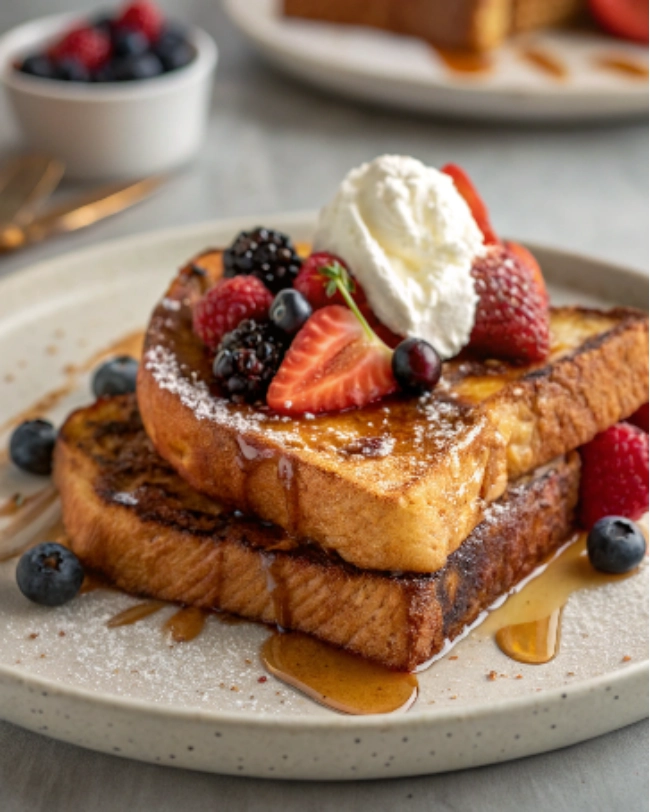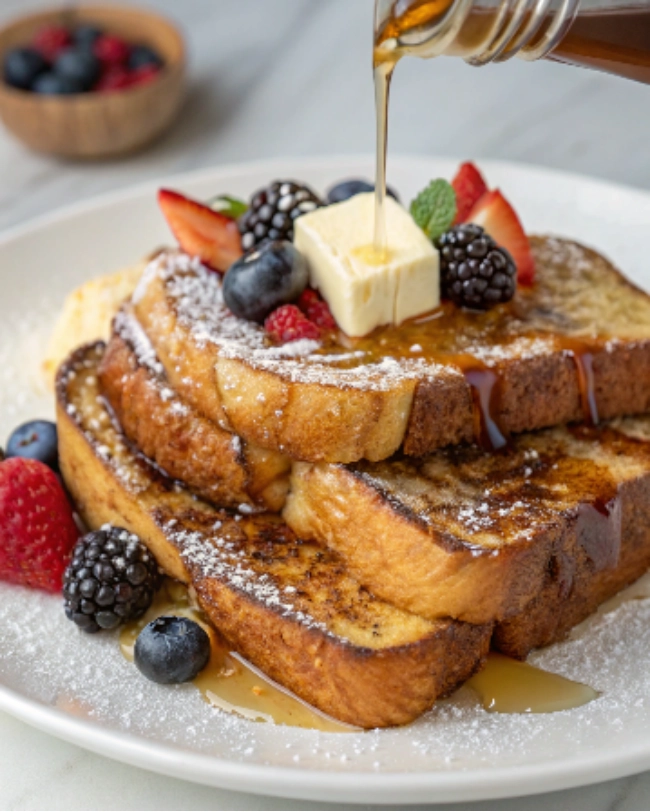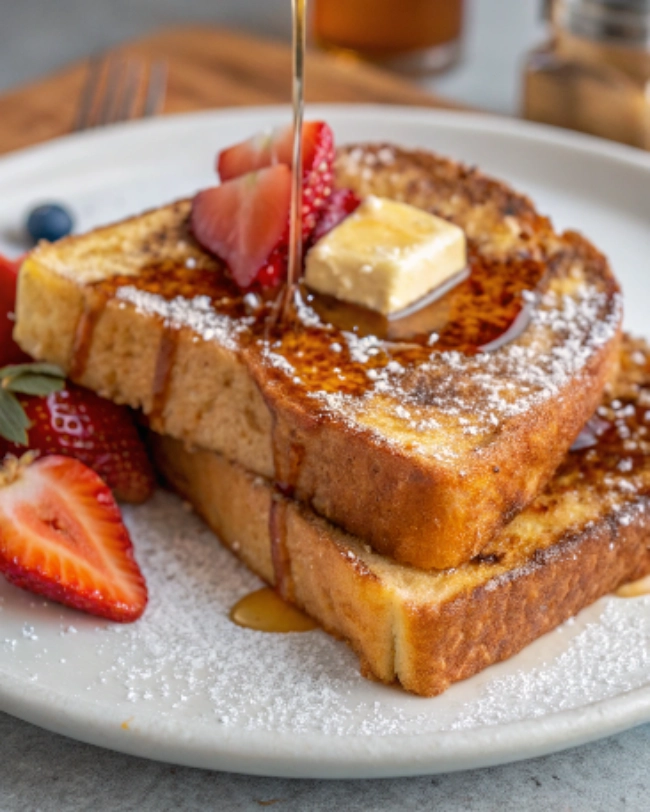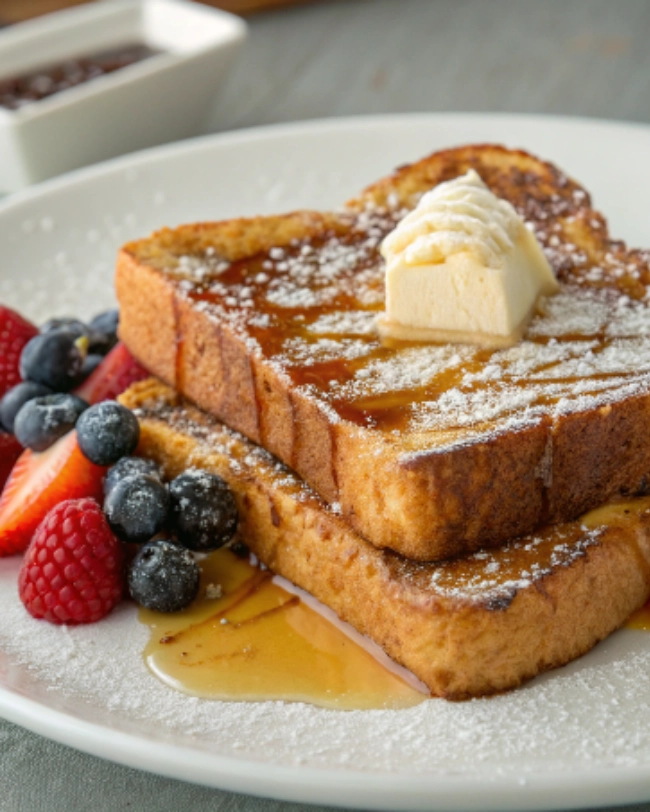Breakfast has long been celebrated as the most important meal of the day, and there’s hardly a dish that embodies indulgence quite like French toast. When you combine the age-old tradition of French toast with the tangy allure of sourdough bread, you get a dish that is not only irresistibly delicious but also loaded with character and culinary history. In this extensive guide, we’ll take you on a journey through the origins of French toast and sourdough, reveal the secrets behind their perfect pairing, and provide you with foolproof recipes and innovative twists including a mouthwatering sourdough French toast casserole.

Whether you’re an experienced cook or a beginner eager to experiment, this article is designed to be your ultimate resource. We’ll answer your burning questions, such as “can you make french toast with sourdough bread?” and share expert tips to help you achieve a crispy yet custardy masterpiece every time. So, let’s begin our journey into the world of sourdough French toast and discover why this gourmet breakfast has captured the hearts and taste buds of food lovers everywhere.
The History and Evolution of French Toast and Sourdough Bread
The Origins of French Toast
French toast is a dish that has roots stretching back to ancient times. Although many assume its origin lies in France, historical records show that versions of this dish have been enjoyed across cultures and continents. In fact, ancient Romans are believed to have been the first to combine bread with a mixture of milk and eggs, frying it in oil to create a nourishing meal. This early form of French toast was not just a way to start the day; it was a practical method of reviving stale bread and turning it into something both filling and delicious.

As centuries passed, French toast evolved in many countries. In medieval Europe, it was known as “pain perdu” (which means “lost bread”), referring to the idea of rescuing old, stale bread and turning it into a meal worth savoring. By the 17th and 18th centuries, the dish had spread across Europe and eventually made its way to the United States, where it became a beloved breakfast staple. Each region added its own flair be it in the choice of spices or the type of bread used—making French toast a versatile and adaptive recipe.
A Brief History of Sourdough Bread
Sourdough bread, on the other hand, carries a history that is equally rich and compelling. This ancient form of bread-making is believed to have originated over 4,000 years ago. Unlike breads that use commercial yeast for rising, sourdough relies on a naturally occurring “starter”—a mixture of flour and water that captures wild yeast and lactobacilli from the environment. This natural fermentation process not only leavens the dough but also imparts a unique tangy flavor that distinguishes sourdough from other breads.
For centuries, sourdough was the standard for bread production. It wasn’t until the advent of modern baking methods and commercial yeasts that sourdough became less common. However, in recent years, there has been a resurgence of interest in artisanal baking and traditional methods. Home bakers and professional chefs alike have rediscovered the magic of sourdough, celebrating its complexity, nutritional benefits, and robust flavor. This revival has paved the way for creative culinary applications, including the transformation of sourdough into the base for the ever-popular French toast.
The Intersection of Two Classics
When the time-honored traditions of French toast and sourdough bread converge, the result is nothing short of spectacular. The natural acidity and chewy texture of sourdough bring a distinct character to the custard-soaked bread, creating a balance of flavors and textures that is hard to beat. This fusion has given rise to variations such as french toast with sourdough bread and innovative recipes like the sourdough french toast casserole.
The synergy between sourdough and French toast lies in their shared heritage of transforming simple ingredients into culinary masterpieces. While French toast is a celebration of simple pantry staples like eggs and milk, sourdough adds an element of rustic sophistication. Together, they create a dish that is both comforting and gourmet a perfect testament to the enduring appeal of traditional cooking methods infused with modern creativity.
Understanding Sourdough French Toast
What Is Sourdough French Toast?
Sourdough French toast is, at its essence, the classic dish reinterpreted with the inclusion of sourdough bread. Traditional French toast recipes typically rely on soft, mass-produced bread varieties that readily absorb the custard mixture. However, when you opt for sourdough, you introduce a complexity of flavor that transforms this everyday breakfast into a gourmet treat. The naturally fermented sourdough offers a pleasantly tangy taste that contrasts beautifully with the sweet, rich custard.
This variation has quickly garnered a devoted following among food enthusiasts who appreciate the unique texture and taste of sourdough. When preparing sourdough French toast, the goal is to achieve a perfect balance where the bread soaks up just enough of the custard to be moist and flavorful without losing its structural integrity. The result is a dish that is both crispy on the outside and delectably soft on the inside a combination that makes every bite a memorable experience.

Why Choose Sourdough Bread for French Toast?
There are several compelling reasons to choose sourdough bread as the foundation for your French toast:
Enhanced Flavor: Sourdough’s natural tang provides a depth of flavor that elevates the custard-soaked bread. The subtle sour notes complement the sweetness of the custard, creating a harmonious taste profile.
Improved Texture: The robust structure of sourdough bread allows it to better withstand soaking in the egg mixture, reducing the risk of the bread becoming overly soggy. This ensures that you get a desirable contrast between the crispy exterior and soft interior.
Nutritional Benefits: Sourdough is renowned for its potential health benefits. The fermentation process increases the bioavailability of nutrients and can make the bread easier to digest. Additionally, sourdough generally has a lower glycemic index compared to conventional breads, which may contribute to more stable blood sugar levels.
Artisanal Appeal: Using sourdough brings a touch of artisanal craftsmanship to your breakfast. Its rustic appearance and flavor make it a popular choice among food enthusiasts who value quality ingredients and traditional methods.
By opting for sourdough, you’re not just making French toast you’re creating a gourmet experience that pays homage to centuries of culinary tradition.
The Unique Texture and Flavor Profile
The true magic of sourdough French toast lies in its texture and flavor. When you dip a slice of sourdough into a rich custard mixture, the bread absorbs the liquid while retaining its distinct structure. This process results in a layered texture that is both crunchy and tender. As the bread fries, the exterior caramelizes into a golden, crispy crust, while the interior remains soft and custardy.
This textural interplay is enhanced by the natural tang of sourdough, which cuts through the sweetness of the custard and adds complexity to every bite. Whether you prefer your French toast served with a dusting of powdered sugar, a drizzle of maple syrup, or an assortment of fresh fruits, the sourdough base provides a robust flavor that elevates the dish from ordinary to extraordinary.
Health Benefits of Sourdough French Toast
Nutritional Advantages of Sourdough Bread
While French toast is often considered an indulgence, using sourdough bread can offer several nutritional benefits that set it apart from traditional recipes. Here are some of the key advantages:

Enhanced Digestibility: The natural fermentation process used in sourdough breaks down some of the gluten and other proteins in the flour, making it easier to digest for many people. This can be particularly beneficial for those with mild sensitivities.
Lower Glycemic Index: Sourdough bread generally has a lower glycemic index than many commercially produced breads. This means it causes a slower, more gradual rise in blood sugar levels, which can help maintain energy levels and reduce sugar spikes.
Rich in Nutrients: Sourdough is a good source of essential vitamins and minerals, including B vitamins, iron, and magnesium. The fermentation process not only preserves these nutrients but may also increase their bioavailability, allowing your body to absorb them more efficiently.
Probiotics and Gut Health: Although the baking process may reduce the number of live bacteria, the fermentation process can still contribute beneficial by-products that support a healthy gut microbiome.
When you prepare a plate of sourdough French toast, you’re treating yourself to a dish that not only delights your taste buds but also offers tangible nutritional benefits.
Balancing Indulgence with Wellness
Sourdough French toast strikes a perfect balance between indulgence and health. While it is undeniably a treat for the senses, the use of sourdough bread allows you to enjoy a decadent breakfast with a bit more nutritional confidence. Here are some strategies for balancing flavor with wellness:
Mindful Portion Control: Enjoy your French toast in moderation by pairing it with a side of fresh fruit or a light salad. This approach allows you to savor the flavors without overindulging.
Healthier Additions: Boost the nutritional profile of your dish by topping your French toast with antioxidant-rich berries, nuts, or even a dollop of Greek yogurt. These additions not only enhance the flavor but also provide essential vitamins and minerals.
Smart Substitutions: Consider using alternatives like almond milk or oat milk in your custard for a dairy-free option that still offers creaminess and flavor. Experiment with natural sweeteners like honey or maple syrup in place of refined sugars.
By incorporating these strategies, you can enjoy a breakfast that is both indulgent and mindful of your overall health.
Mindful Eating and Savoring Every Bite
Mindful eating is more than just a trend it’s a practice that encourages you to slow down, appreciate your food, and savor each bite. With sourdough French toast, the intricate interplay of textures and flavors provides the perfect opportunity to engage in mindful eating. As you bite into the crispy exterior and the soft, custard-infused center, take a moment to appreciate the craftsmanship behind the dish. Notice the aroma of toasted sourdough mingled with the sweetness of the custard, the warmth of the spices, and the subtle tang that lingers on your palate.
This approach not only enhances your dining experience but also encourages a healthier relationship with food. By focusing on the flavors and textures, you naturally find satisfaction in each bite, leading to a more balanced and gratifying meal experience.
How to Make the Perfect Sourdough French Toast
Creating the ideal sourdough French toast requires attention to detail, quality ingredients, and a few expert techniques. Whether you’re making a quick weekday breakfast or planning an elaborate brunch, these step-by-step instructions will ensure you achieve a dish that is both visually stunning and incredibly delicious.

Essential Ingredients and Equipment
Before you begin, it’s important to assemble all the necessary ingredients and tools. Here’s what you’ll need:
Sourdough Bread: Choose a high-quality, slightly stale loaf of sourdough. Stale bread works best because it soaks up the custard without disintegrating.
Eggs: Large, farm-fresh eggs create the base of your custard.
Milk or Cream: Whole milk, heavy cream, or a blend of both will give you a rich, velvety custard.
Sweeteners: Options include sugar, honey, or maple syrup. Adjust according to your taste.
Spices: Cinnamon, nutmeg, and a pinch of salt are essential for flavor.
Vanilla Extract: A teaspoon or two will enhance the aroma and taste.
Butter or Oil: For frying, use enough to coat your skillet evenly.
Optional Add-ins: Fresh fruits, nuts, powdered sugar, or even a drizzle of caramel sauce for serving.
In addition to these ingredients, be sure to have a large mixing bowl, a shallow dish for soaking the bread, a non-stick skillet or griddle, and a spatula for flipping.
Step-by-Step Sourdough French Toast Recipe
Follow this detailed recipe to create the ultimate sourdough french toast recipe:
Prepare the Custard:
In a large bowl, whisk together 6 large eggs with 1½ to 2 cups of milk (or a mix of milk and cream for extra richness). Add 2 tablespoons of sugar, 1 teaspoon of vanilla extract, 1 teaspoon of cinnamon, a pinch of nutmeg, and a pinch of salt. Whisk vigorously until the mixture is uniformly smooth and fully combined. This custard forms the heart of your French toast.
Preheat the Skillet:
Place a large non-stick skillet or griddle over medium heat. Add a generous knob of butter or a splash of oil and let it melt evenly, ensuring a non-stick surface for frying.
Soak the Sourdough Bread:
Slice your sourdough bread into thick slices (about 1 to 1½ inches thick). Lay each slice in a shallow dish and pour the custard mixture over them. Allow the bread to soak for at least 30 seconds on each side. For an even richer flavor, you can let the bread sit in the custard for up to 2 minutes but be cautious not to oversoak if your bread is very soft.
Frying the Bread:
Once the bread has absorbed the custard, transfer each slice carefully to the heated skillet. Fry for about 3-4 minutes on each side, or until each slice develops a beautiful, golden-brown crust. Adjust the heat as needed to ensure the custard inside remains soft while the exterior crisps perfectly.
Finishing Touches:
Remove the French toast from the skillet and place it on a paper towel-lined plate to drain any excess oil. For added decadence, drizzle with maple syrup, dust with powdered sugar, or top with your favorite fruits and nuts before serving.
Troubleshooting and Common Mistakes
Even the best recipes can run into a few hiccups. Here are some troubleshooting tips for perfecting your sourdough French toast:
Avoiding Sogginess:
Use bread that is a day or two old; very fresh sourdough can become too soggy. Ensure each slice is evenly soaked, but do not let it sit too long if your bread is delicate.
Perfect Browning:
Maintain medium heat throughout cooking. High heat may burn the exterior while leaving the custard inside undercooked, whereas too low heat might result in a pale, unappetizing finish.
Custard Consistency:
If your custard seems too thick, add a splash more milk to ensure it fully penetrates the bread. Conversely, if it’s too runny, a few extra eggs can help maintain a thicker coating.
Can You Make French Toast with Sourdough Bread?
The answer is an unequivocal yes. Not only can you make French toast with sourdough bread, but doing so enhances the flavor and texture of the dish dramatically. Sourdough’s inherent tang and firm structure make it the perfect candidate for absorbing a rich custard, resulting in a dish that is both visually stunning and supremely satisfying. With the step-by-step process outlined above, you’ll find that transforming sourdough into a gourmet breakfast treat is as simple as it is rewarding.
Exploring Creative Variations of Sourdough French Toast
While the classic sourdough French toast recipe is a treat in itself, there’s plenty of room for innovation. Whether you have a penchant for sweet indulgences or a taste for savory dishes, here are several creative variations to take your French toast game to the next level.

Sweet Variations and Flavor Enhancements
For those who crave a dessert-like breakfast experience, consider these sweet twists:
Fruit-Infused Custard:
Puree fresh berries or a ripe banana into your custard for a naturally sweet and fruity variation. The added flavor not only brightens the dish but also lends a beautiful color that makes your plate pop.
Nutty Crunch:
Incorporate finely chopped nuts—such as almonds, walnuts, or pecans—either directly into the custard or as a topping once the French toast is cooked. The crunch and earthy flavor of the nuts complement the tangy sourdough wonderfully.
Caramelized Variations:
For a decadent treat, consider topping your French toast with a drizzle of homemade caramel sauce or even a sprinkle of sea salt. This sweet-and-salty combination elevates the overall taste experience and adds an extra layer of complexity.
Seasonal Delights:
Embrace seasonal ingredients by adding slices of apples and a dusting of cinnamon in the fall, or fresh peaches and a hint of ginger in the summer. These seasonal touches not only enhance the flavor but also make the dish feel timely and refreshing.
Savory Sourdough French Toast Options
Not every morning calls for something sweet. If you’re in the mood for a savory twist on this classic dish, try these variations:
Herb-Infused Custard:
Add finely chopped fresh herbs like basil, thyme, or chives to the custard. A small amount of grated Parmesan or a dash of black pepper can further elevate the flavor profile, making your sourdough Bread French toast a unique brunch option.
Cheese and Beef:
For a heartier version, consider layering your sourdough French toast with melted cheese and crispy beef. The combination of salty beef, creamy cheese, and tangy sourdough creates a well-balanced dish that works perfectly for a weekend brunch.
Eggs Benedict Twist:
Transform your French toast into a brunch masterpiece by topping it with a perfectly poached egg and a light hollandaise sauce. This twist on the classic Eggs Benedict offers a new way to enjoy the familiar flavors of sourdough.
Avocado and Tomato:
For a lighter yet satisfying option, serve your sourdough French toast with sliced avocado and fresh tomato. A drizzle of olive oil and a sprinkle of sea salt round out this healthy, savory variation.
International Inspirations
Different cultures bring their own flair to French toast. Experiment with international ingredients to create a dish that is truly one-of-a-kind:
French-Style with Brioche:
While traditional French toast often calls for brioche, using sourdough in a French-style preparation can offer a unique twist. Add a dash of Grand Marnier to the custard and serve with a sophisticated orange compote.
Latin American Twist:
Incorporate spices such as cinnamon and cloves, and serve with dulce de leche for a Latin-inspired version. The sweet, creamy caramel sauce contrasts beautifully with the sourdough’s tang.
Asian Fusion:
Experiment by adding a touch of matcha or ginger to the custard, and serve with a drizzle of honey and a sprinkle of toasted sesame seeds for an unexpected yet delightful flavor profile.
Sourdough French Toast Casserole: A Family Favorite
What Is a Sourdough French Toast Casserole?
For gatherings, brunch parties, or busy mornings when you need to feed a crowd, a sourdough French toast casserole is an ideal solution. This variation takes the individual slices of sourdough French toast and transforms them into a layered, baked dish that melds the flavors overnight. The casserole is not only convenient but also offers a rich, communal experience that’s perfect for sharing.

Detailed Recipe for Sourdough French Toast Casserole
Here’s how to prepare a mouthwatering sourdough french toast casserole:
Ingredients:
1 large loaf of sourdough bread, cut into cubes
8 large eggs
2 cups of whole milk (or a mix of milk and cream)
1 cup heavy cream (optional, for extra richness)
1/2 cup granulated sugar
2 teaspoons vanilla extract
1/2 teaspoons ground cinnamon
1/2 teaspoon ground nutmeg
A pinch of salt
Optional mix-ins: fresh berries, sliced bananas, chopped nuts, or chocolate chips
Preparation:
Grease a large casserole dish generously with butter.
Spread the sourdough bread cubes evenly throughout the dish.
In a separate large bowl, whisk together the eggs, milk, heavy cream, sugar, vanilla, cinnamon, nutmeg, and salt until smooth.
Pour the custard mixture evenly over the bread cubes, ensuring that every piece is well saturated.
If you’re adding fruit or nuts, sprinkle them over the top at this stage.
Cover the dish and chill it in the refrigerator for a minimum of 4 hours, or ideally overnight. This allows the bread to fully absorb the custard and meld the flavors together.
Baking:
Preheat your oven to 375°F (190°C).
Remove the casserole from the refrigerator and let it come to room temperature for about 20-30 minutes.
Bake uncovered for 45-60 minutes, or until the top is beautifully golden and the custard is set.
For an extra-crispy top, switch the oven to broil for 2-3 minutes at the end but watch carefully to avoid burning.
Customization Ideas and Variations
A sourdough French toast casserole is incredibly versatile. Here are some ideas to tailor it to your tastes:
Mixed Berry Casserole:
Add a generous layer of mixed berries (blueberries, raspberries, and strawberries) between the layers of bread for a burst of flavor and color.
Nutty Crunch:
Sprinkle toasted pecans or walnuts over the top before baking to add a satisfying crunch.
Vegan Variation:
Substitute the eggs with a plant-based egg alternative and use almond or soy milk instead of dairy to create a vegan-friendly version that still captures the essence of the dish.
Spicy Kick:
For those who love a bit of heat, add a small pinch of cayenne pepper to the custard. The subtle spice pairs surprisingly well with the sweetness of the dish.
Serving Suggestions and Pairing Ideas
A well-made sourdough French toast casserole is best enjoyed with thoughtful accompaniments. Consider these ideas for a complete brunch experience:
Fresh Fruit Salad:
A colorful mix of seasonal fruits complements the rich flavors of the casserole.
Whipped Cream or Yogurt:
A dollop of freshly whipped cream or a serving of Greek yogurt can add a creamy, tangy contrast.
Beverage Pairings:
Serve with freshly squeezed orange juice, a smooth latte, or even a mimosa for an extra touch of elegance.
Expert Tips and Tricks for Making the Best Sourdough French Toast
Even the simplest dish can be perfected with a few expert techniques. Here are some advanced tips to ensure your sourdough French toast consistently impresses:

Choosing the Right Sourdough Bread
The success of your dish largely depends on the quality of the sourdough bread. Look for:
Artisanal Loaves:
Seek out bread made by local bakers who use traditional fermentation methods.
Slightly Stale Bread:
Day-old sourdough tends to absorb the custard more effectively, maintaining structure without becoming mushy.
Proper Texture:
A good sourdough should have a chewy, robust texture that stands up to soaking and frying.
Marinating and Flavor Infusion Techniques
Maximize the flavor of your French toast by:
Extended Soaking:
Allow the bread to soak longer if you desire a richer, more custard-like interior especially for thicker slices.
Double Dipping:
For an extra burst of flavor, dip the bread in the custard twice. Let it rest briefly between dips.
Flavor Boosters:
Experiment with infusing your custard with additional spices or extracts (like almond or orange) for a personalized twist.
Cooking Methods: Stove, Oven, or Griddle?
Different methods offer distinct results:
Stovetop Frying:
Ideal for individual servings, ensuring a crispy exterior. Use a non-stick skillet over medium heat.
Oven Baking:
Best for casseroles or large batches, offering even cooking and a uniform texture.
Griddle Cooking:
Perfect for preparing multiple slices at once, providing a consistent sear and allowing you to cook for a crowd.
Enhancing Presentation and Serving
Aesthetics are just as important as flavor:
Garnishing:
Top your French toast with edible flowers, fresh mint, or a dusting of powdered sugar for visual appeal.
Creative Plating:
Arrange slices artfully on a plate, and add a side of fruit or a small drizzle of extra syrup.
Temperature:
Serve immediately while hot to preserve the ideal contrast of a crisp exterior and soft interior.
Frequently Asked Questions (FAQs)
Can You Make French Toast with Sourdough Bread?
Absolutely. Using sourdough bread for French toast not only works but often produces a superior dish due to its tangy flavor and hearty texture. The process is similar to making traditional French toast, with the added bonus of a more complex flavor profile.
What Makes Sourdough French Toast Different?
The key difference is the bread itself. Sourdough brings a natural tang, improved texture, and potential health benefits that set it apart from commercial breads. This results in a dish that is both unique and memorable, with every bite offering a balance of crispness and custard-infused softness.
How Can I Perfect My Sourdough French Toast Recipe?
Experimentation is key. Adjust the soaking time, the ratio of eggs to milk, and the cooking temperature to suit your taste. Use slightly stale sourdough, and consider double-dipping for an extra flavor punch. Finally, don’t be afraid to tweak the spices and add your own signature ingredients.
What Are the Best Toppings and Sides?
The options are endless. For sweet variations, try fresh berries, banana slices, or a drizzle of maple syrup. For savory options, consider a sprinkle of sea salt, a dollop of Greek yogurt, or even avocado slices. Pair your French toast with a light fruit salad or a warm cup of coffee to round out the meal.
Real Stories, Testimonials, and Variations from Home Cooks
Personal Experiences with Sourdough French Toast
Many home cooks have shared their love for sourdough French toast. One avid food blogger recounted how her discovery of using day-old sourdough transformed her weekly breakfast routine into an eagerly anticipated event. She described the delight of biting into a slice that balanced a perfectly crispy exterior with a moist, custard-soaked interior. Friends and family soon began requesting her version of the dish, praising its unique flavor and texture.

Another home cook mentioned that switching from regular bread to sourdough not only improved the taste of his French toast but also sparked a newfound appreciation for traditional baking methods. He explained that every bite evoked memories of artisanal bakeries and the rich, tangy flavor that only sourdough could offer.
Social Media Trends and Reviews
Social media platforms are buzzing with posts about french toast with sourdough. Instagram feeds are filled with aesthetically pleasing photos of golden, crispy slices drizzled with syrup and garnished with fresh fruit. Users have shared videos demonstrating their secret techniques, from the perfect soak time to the ideal heat settings for frying. These shared experiences have fostered a vibrant community that celebrates both the art and science of making the perfect sourdough French toast.
Expert Chef Insights and Recommendations
Renowned chefs have also weighed in on the merits of using sourdough for French toast. Many emphasize that the key to a truly gourmet dish lies in the quality of ingredients. They recommend using artisanal sourdough and fresh, organic eggs to achieve the best flavor. Additionally, they advise that a carefully balanced custard one that incorporates just the right amount of sweeteners and spices can elevate the dish to restaurant-quality levels.
Conclusion
In conclusion, sourdough French toast represents the perfect marriage of tradition and innovation. By using sourdough bread, you infuse a classic dish with a tangy, robust flavor that elevates the humble breakfast into a gourmet experience. Whether you enjoy it as a simple weekday treat or as part of an elaborate brunch spread, this dish offers a sensory journey that balances crispy exteriors, soft custard interiors, and a delightful interplay of spices and sweetness.

We encourage every home cook to experiment with the recipes and techniques outlined in this guide. The beauty of sourdough French toast lies in its versatility its foundation is robust enough to support a wide array of creative variations. Whether you’re adding seasonal fruits, experimenting with savory toppings, or even transforming it into a casserole for your next gathering, innovation is at the heart of what makes this dish so special.
